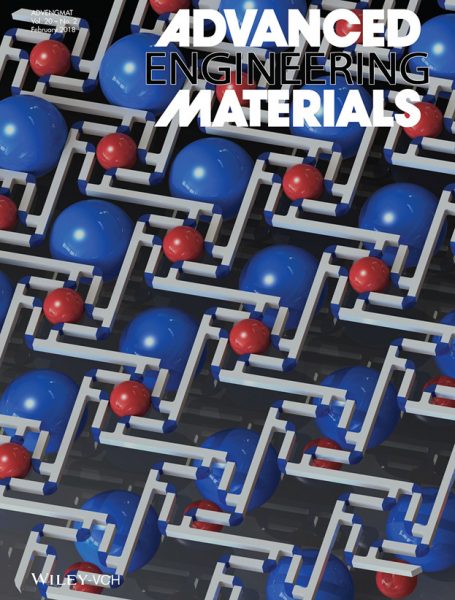Advanced Engineering Materials has been bringing you the latest breakthroughs in structural materials that are making those important first steps toward commercialization since 1999. With its further increased, record-high Impact Factor of 2.319 (2017 Journal Citation Reports), the journal covers a variety of key topics, such as composites, ceramics, intermetallics, and coatings, and also high-temperature, cellular, and biomedical materials, with a strong focus on new manufacturing techniques.
No access to our published content? Make sure to recommend Advanced Engineering Materials to your librarian. More information can be found here.
In this monthly feature, we highlight the research behind the artwork on the covers of the most recent issue of Advanced Engineering Materials, as well some of the most read Advanced Engineering Materials publications over the last month. These top-downloaded articles are currently freely accessible! Click on the titles below to get to the corresponding papers.
You can find this month’s issue here. Also check out our previous Engineering Digest here and here.

Novel 3D-Printed Hybrid Auxetic Mechanical Metamaterial with Chirality-Induced Sequential Cell Opening Mechanisms
by Yunyao Jiang and Yaning Li
Inspired by the responsive chromatophores on the skin of Cephalopods, novel hybrid auxetic chiral mechanical metamaterials were designed and fabricated by Yaning Li et al. from the University of New Hampshire via 3D printing to achieve dramatic volume change and a unique sequential cell-opening mechanism. The new design concepts can be used to develop new multifunctional smart composites, sensors, and/or actuators that are responsive to external load and/or environmental conditions, for applications in drug delivery and color changing for camouflage.
A more extensive news article about this study can be found here.
Metal Alloys for Fusion‐Based Additive Manufacturing
by Duyao Zhang, Shoujin Sun, Dong Qiu, Mark A. Gibson, Matthew S. Dargusch, Milan Brandt, Ma Qian, and Mark Easton
Additive manufacturing is an emerging manufacturing technique that sequentially builds up a 3D structure. In particular, additive manufacturing of metal structures has inherent advantages over conventional manufacturing: improved complexity, shorter processing times, and saving waste.
In their recent review in Advanced Engineering Materials Mark Easton and colleagues from the RMIT University of Melbourne, Australia, have presented an overview of alloys available for additive manufacturing. They not only include common alloys made from titanium, steel, nickel, and aluminum, but also less common alloys such as magnesium alloys and low melting point alloys, as well as compositionally complex alloys including bulk metallic glasses and high entropy alloys. The focus of the review is on the relationship between composition, processing, microstructures, and properties of each alloy system.
A Review of Metal Fabricated with Laser- and Powder-Bed Based Additive Manufacturing Techniques
by Jun Yi
Additive manufacturing has multiple advantages over conventional fabrication techniques, such as the geometrical freedom and, to a great extent, the omission of tooling equipment. Hence, futuristic designs and non-standard topology-optimized structures can be fabricated without causing noteworthy extra cost. What at first glance appears as an engineer’s dream, introduces its complexity in the description of the material’s characteristics and their volatility to the manufacturing conditions. This article by Leonhard Hitzler et al. from Griffith University provides detailed overviews of the progress to date for aluminum-, iron-, titanium-, cobalt-, and nickel-based raw materials. Furthermore, an overview of the state-of-the-art in the medical sector is included, comprising the areas of utilization and several trail studies.
Recent Advances of Low Biological Toxicity Ag2S QDs for Biomedical Application
by Chenghao Lu, Guihuan Chen, Bing Yu, and Hailin Cong
Ag2S quantum dots (QDs) have been widely studied and used in biomedical applications owing to their excellent optical properties and good biocompatibility. Hailin Cong and colleagues from Qingdao University provide an overview of recent advances in the preparation, surface modification, and biomedical applications of Ag2S QDs, with a particular focus on biological imaging and nanomedicine. Additionally, the review presents important insights into the overall situation, challenges, and future potential clinical applications in this field.

















